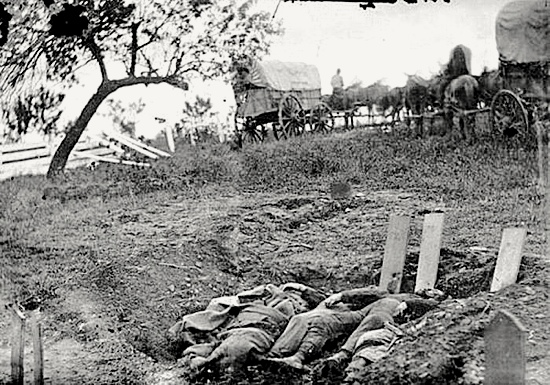Civil War: The dead from Gettysburg return home
150 years ago in Gettysburg, thousands of Confederate soldiers were buried in shallow, unmarked graves. 140 years ago, the process of returning some of those soldiers to Hollywood Cemetery began.

It’s a little hard to imagine Gettysburg after the three days of fighting that took place there in July of 1863. Thousands of dead soldiers and horses littered the battlefield, and a horrible stench filled the town and surrounding area. Rains that followed the battle washed away the shallow graves that had been dug for fallen soldiers, and an even greater number of dead soldiers had never been buried at all. Diaries of townspeople and those left behind to “clean up” told of the horrible aftermath of the battle.
With the battle taking place so far into Union territory, burying the dead fell to the responsibility of those with Union sympathies. In the months after the battle, many Union soldiers were disinterred and laid to rest in their home states or in the Soldiers’ National Cemetery at Gettysburg (the cemetery to which Lincoln gave his famous “Gettysburg Address” as a dedication). Confederate soldiers were largely buried individually where they fell, or in mass, shallow, unmarked graves at various locations on the battlefield. While the Union soldiers found their final resting place in a few months, the vast majority of the Confederates would remain buried on the battlefield for nine more years.
It wasn’t until 1871 that real efforts began to bring the dead Confederate soldiers home. Many organizations like Richmond’s own Hollywood Memorial Association raised funds to reinter the soldiers in cemeteries in their home states. However, this was quite a daunting task, as there were no official burial records. Much of the credit for the effort goes to two men: Dr. Rufus Weaver, the man contracted to supervise the effort, and Dr. John W.C. O’Neal, a Virginian who lived in Gettysburg and had documented numerous places where Confederate soldiers were buried in and around the town.
Dr. Weaver’s efforts over a three year period would result in the reinterment of of 3,320 soldiers, the vast majority of which were unidentified and laid to rest in Hollywood Cemetery. Dr. Weaver personally supervised the efforts and insisted on handling the remains himself to ensure the greatest care was taken. His father, Samuel Weaver, had supervised the reinterment of the Union dead after the battle, so he likely saw this task as a matter of family duty passed down to him.
On June 15th, 1872 a ship arrived at Rockett’s Landing with several boxes containing Confederate soldiers from Gettysburg. After the boxes were unloaded, fifteen wagons carried the Confederate dead from Rockett’s through the city in a funeral procession, each wagon escorted by two Confederate veterans. The wagons rode slowly past businesses and buildings draped in black cloth on the way to Hollywood Cemetery. A witness of the procession said that “many eyes were filled with tears and many a soldier’s widow and orphan turned away from the scene to hide emotion.”
About 2,000 of Gettysburg’s unknown Confederate dead still rest in Hollywood Cemetery in a spot known as Gettysburg Hill. Many of the Virginians who fell during Pickett’s Charge lay only a few yards away from the resting place of Pickett himself, a decision he made before he passed–to be near his division who fell at Gettysburg. Dr. Weaver’s tireless work gave thousands of Confederate soldiers a proper burial and a home in Hollywood Cemetery, but an unknown number of Confederate dead still lay buried on the fields at Gettysburg, undiscovered, their graves lost to the passing of history.
-
Recommend this
on Facebook -

Report an error
-

Subscribe to our
Weekly Digest




There are 3 reader comments. Read them.